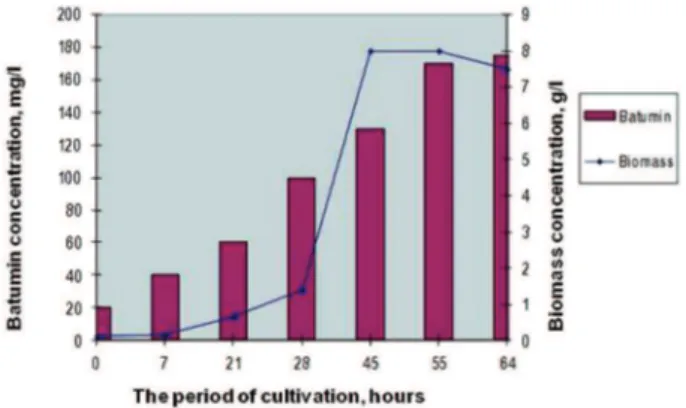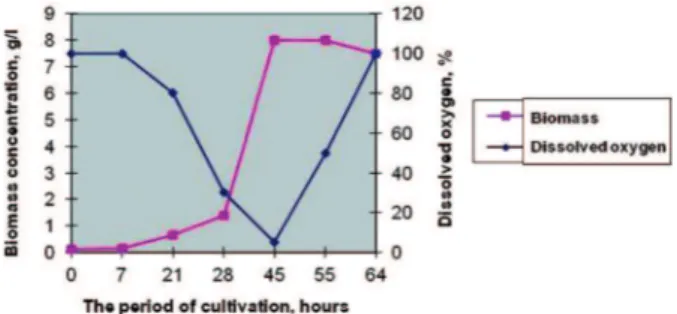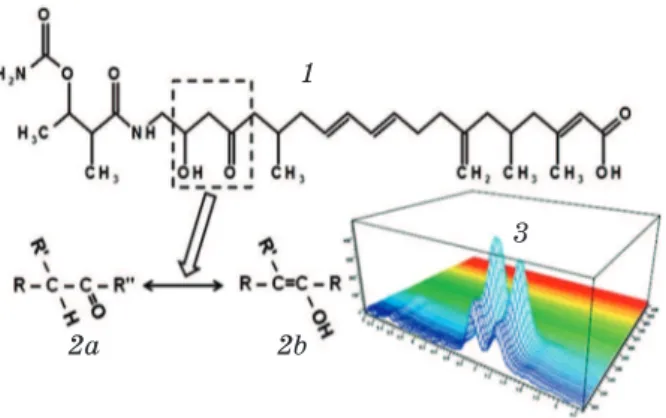Representatives of Pseudomonas consist of more than 120 species and possess a great biotechnological potential. They produce antimicrobial compounds of the different chemical structure: aromatic and heterocyclyc, antibiotics-monobactames, aminoglycosides, polypeptides, polyketides etc. [1]. Polyketides are numerous biologically active compounds including antibiotics, anticancer agents and immunodepressants, which are made as a result of consecutive enzymatic condensation from elementary segments, which have two carbon atomes and β-carbon always has a keton group.
Polyketide family includes pseudomonic acid which is obtained from P. fluorescens [2] and antistaphylococcal antibiotic batumin [3], its strain Pseudomonas batumici was isolated from subtropical soil [4]. Batumin gross formula, С30Н48N2O7 and its chemical structure were established [5]. This antibiotic possesses high selective activity against staphylococci, in particular to strains which are polyresistant to antibiotics. The promising way of batumin usage is in case of staphylococcal nasal carriage. As a treatment is used 0.1% batumin liniment and the usage
of batumin disks in case of mass examination of patients and staff for Staphylococcus aureus nasal carriage makes diagnostics faster and easier [6].
Chemical synthesis of the antibiotic is complicated due to its high molecular mass and the presence of unsaturated fragments in the molecule. So, microbial cultivation of P. batumici seems to be more available.
The aim of this work was to study the regularities of both: batumin biosynthesis and the growth of producing strain under the condition of submerged cultivation and to analyse some physicochemical properties of this antibiotic.
Materials and Methods
The object of investigation was the type strain Pseudomonas batumici В-321 from Ukrainian collection of microorganisms (UCM), which is supported in the Antibiotics Department of Microbiology and Virology Institute of NAS of Ukraine [4].
Fermentation was carried out by the method of submerged cultivation in fermenter Biostat М5 (Germany) with the complete system
UDK 577.181.4 doi 10.15407/biotech7.06.046
BIOSYNTHESIS AND PROPERTIES
OF ANTIBIOTIC BATUMIN
Key words: batumin, biosynthesis, diastereoisomeria.
V. V. Klochko Istitute of Micribiology and Virology
of the National Academy of Sciences of Ukraine, Kyiv
Е-mail: vvklochko@ukr.net
Received 26.05.2014
Biosynthesis of antistaphylococcal antibiotic batumin under periodic conditions of Pseudomonas batumici growth has been studied. Antibiotic synthesis in fermenter occurred across the culture growth and achieved its maximal value after 50–55 hours. The active oxygen utilization by the producing strain was observed during 20–55 hours of fermentation with maximum after 40–45 hours. Antibiotic yield was 175–180 mg/l and depended on intensity of aeration.
In contrast to «freshly isolated» antibiotic after fermentation the long-term kept batumin has shown two identical by molecular mass peaks according to the chromato-mass spectrometric analysis. Taking into account of batumin molecule structure the conclusion has been made that the most probable isomeri-zation type is keto-enolic tautomerism. At the same time batumin is diastereoisomer of kalimantacin A which has the same chemical structure. The optic rotation angle is [a]d25 = +56.3° for kalimantacin and [α]d25 = –13.5° for batumin.
of automation and control of cultivation parameters. The volume of the fermenter was 5 l; the coefficient of charge was 0.6.
The volume of nutrient medium was 1.5 l; the aeration degree — 1.0; dose of inoculum- 1%; temperature — 25 °С; cultivation period — 65 hours. The frequency of rotation of the fermenter stirrer was changed from 250 to 700 rpm depending on the oxygen uptake of the culture. The composition of nutrient medium and the methods for determination of batumin concentration were shown [7, 8]. The biomass concentration was determined by the optical density of cell suspension with the following terms of absolutely dry mass of cells according to the calibration graph.
The minimal inhibitory concentration was established by titration using the test-strain Staphylococcus aureus UCM B-4001 (ATCC 6538Р) [3].
Extraction was carried out from acidified P. batumici culture fluid by chloroform (1:2), extract was evaporated in vacuo. To carry out preparative chromatography the column 20×1.5 cm was used (solid phase: silicagel (Fluka, USA), pore size 40–100 μm; liquid phase-benzene: acetone (1:1). Batumin yield was detected by TLC using Merk plates; plate fixation was done with iodine vapor. All fractions which contained activity were collected and evaporated in vacuo.
Chromatographic analysis of culture fluid obtained after centrifugation was carried out by HPLC using liquid chromatograph Agilent 1200 with mass spectrometric detector Agilent G1956B. Chromatographic system was the following: column XDB-C18 (Zorbax 150 mm × 4.6 mm × 5 μm) with nonpolar octadecyl group (reversible phase), mobile phase — ACN:H2O (55:45) and 0.5 M solution of ammoniun acetate, temperature of the column was 30 °C, flow rate-1ml/min, isocratic regime, injection 5 μl.
To make a comparison during HPLC analysis we investigated “freshly obtained” batumin, which was purified during fermentation and antibiotic, which was isolated and purified 10 years ago; it was stored at +5÷+8 °С during the whole mentioned period. The purification degree in both cases was 85%.
The product obtained by cultivation was checked for compliance structure of batumin by proton magnetic resonance (PMR). Deyterium acetone was used as a solvent. The sample concentration eluted from the column in the probe destined for PMR was 30 mg/ml. We used tetramethylsilane as the internal standard. Sample temperature
was 25 °С. Measurement was performed on Varian 300 at the radio frequency 300 MHz. Data were processed by computer program NUTS NMR Data Processing Program with a graphical display of PMR signals. The results were compared with PMR data of a decade ago. The optic rotation angle of batumin was determined in 1% purified antibiotic solution in methanol (polarimeter Atago Polax-2 L). Sample temperature was 25 °С. The absolute value of the rotation angle and its sign was calculated with respect to zero [9].
Results and Discussion
It was established that during cultivation of Pseudomonas batumici В-321 in the fermenter (as well as in flasks) the batumin biosynthesis was held in parallel with biomass accumulation (Fig. 1).
P. batumici biomass started to grow in seven hours of cultivation and logarithmic growth phase was observed after 28 hours. The producing strain in the fermenter passed into the stationary phase more quickly than in flasks in the rotary shaker, namely within 45 hours (in flasks-within 65–70 hours). In the fermenter the strain P. batumici В-321 passed all stages of its development for 2.5 days. In contrast it took 4 days for its growing in flasks.
The maximal concentration of P. batumici В-321 biomass in the fermenter was 7.5– 8.0 g/l; economic coefficient according to the substrate was 50%. It corresponds to full uptake of the substrate (glucose). As it was noticed before batumin synthesis was accompanied by the producing strain growth. It was noticed a slight gradual pH decrease in the
medium during the cultivation process. It may have been due to batumin accumulation during cultivation. It is known that this antibiotic has carboxyl group in its structure and it has weak-acid reaction in the solution. The maximal concentration of the antibiotic (175–180 mg/l) was observed after 55 hours of cultivation.
One of the important parameters which are detected in the modern fermenters is the concentration of oxygen dissolved in the medium (DO,%). We have investigated this parameter during P. batumici cultivation (Fig. 2).
After 7 hours of cultivation the active uptake of oxygen by P. batumici В-321 strain was observed. With the growth of culture DO marker decreased to almost zero. So, all oxygen supplied to the medium was completely absorbed by producing strain cells. At this period we noticed the slowdown of culture growth; the batumin concentration reached to its maximal value.
In the scientific literature there are similar data concerning dynamics of oxygen uptake by cultural cells under fermenter condidions. According to [10] the maximal oxygen uptake during the growth of gramicidin C producer was observed at the exponential phase of growth of Bacillus brevis. It was noted that almost zero values of DO in the medium coincided with the beginning of the intensive gramicidin accumulation. According to [11] the maximal oxygen uptake by Streptomyces globisporus was also observed at the exponential phase of growth.
It was noticed that the control of concentration of dissolved oxygen gave an opportunity to increase the level of e-rodomitsinon at the growth phase of Streptomyces peucetius var. caesius [12].
Since during the growth of P. batumici in the fermenter the concentration of dissolved
oxygen was decreased the limitation of cultural growth by oxygen may have taken place. However, when the number of stirrer revolutions was increased the batumin biosynthesis not only did not increase but also suppressed. The maximal antibiotic concentration in this case was only 90–110 mg/l. The antibiotic compound obtained during cultivation was checked for compliance structure of batumin by PMR (Fig. 3).
Batumin which was just obtained after fermentation was analysed and it was made the comparison with the previously purified batumin which was kept for a long period of time (Fig. 3). PMR spectrum was similar with that one which was obtained more than 30 years ago [5]. According to PMR spectrum the proton chemical shifts were the following: 0.8–1.4; 1.8–2.6; 3.2–3.4; 4.0–4.2; 4.7–4.9; 5.5–6.4; 7.2–7.4 ppm).
There were seven signals of olefinic protons and five methyl groups in the complex spectrum. According to chromatography-mass spectrometry analysis the molecular mass of the compounds (peaks 1, 2 and 2′), which were observed in the spectrum, was 548. It corresponds to molecular mass of batumin molecule (Fig. 4).
Fig. 2. Oxygen uptake by P. batumici В-321 in a batch process
Fig. 3. PMR spectrum of batumin antibiotic at fermentation of P. batumici В-321
Fig. 4. HPLC-analysis of batumin: 1 — batumin from cultural liquid;
2, 2′ — after long-term storage
However, unlike “freshly purified” antibiotic obtained as a result of fermentation, in batumin preparation, which was stored for a long term, there was a splitting of the main peak into two similar. Obviously, the antibiotic is able to create certain isomeric forms. Taking into consideration the structure of its molecule we suggest that the most probable isomerization type is keto-enolic tautomerization (Fig. 5).
This type of isomerism is related to the proton movement in the middle of the molecule from one atome to another (at the distance of three atoms relative to the first one). Wherein created isomers may quickly change from one form to another — from ketone to enol and vice versa [13].
There are a lot of systems in organic chemistry which are able to keto-enolic tautomerization. The certain peculiarities of spatial structure of peptides can be explained by the planarity of their peptide bonds. Tautomerization is one of the most important factors for flat location of the peptide bond. In case of binding of pyrimidine bases with ribose nucleotides tautomerism plays the certain role. Similar tautomeric transformations give the possibility to show many biological functions e.g. in case of nicotinamide [13]. However, we
did not find any difference in biological activity of batumin during the cultivation and after long-term storage. The minimal inhibitory concentration of antibiotic was the same for both variants– 0.25 μg/ml. Investigation of chemical properties of batumin allows us to make a conclusion concerning the existence of its other isomers. The chemical structure of kalimantacin A, which was purified by Japanese scientists from Alcaligenes sp. [14], is identical to that one of batumin. However, the last one has different physical and chemical properties. The optic rotation angle is [α]d25 = +56.3° for kalimantacin and [α]d25 = –13.5° for batumin. According to the obtained results we may suggest that both antibiotics are diastereoisomers, which have different signs and different values of the optic rotation angle. So, batumin can not be unambiguously attributed to primary or secondary metabolites because the biomass accumulation of P. batu-mici and batumin biosynthesis occurred in parallel. Batumin was synthesized with the products which are characteristic of the first phase of producer development (proteins, nucleic acids, carbohydrates). So, this antibiotic is a primary metabolite which is vital for P. batumici development. However, the maximal value of its accumulation was obseved at the phase of stunting and stationary phase. According to these characteristics batumin can be considered as a secondary metabolite, which is not vital for producer development.
Obviously, antibiotic formation is not a random process in the vital functions of microorganisms. It is due to certain character of metabolism, which was formed in the course of evolution of this microorganism. So, batumin ability to isomerirization and formation of keto-enolic forms can also play a certain role in metabolism of the producing strain. To attribute batumin to primary or secondary metabolites it is necessary to determine its role in P. batumici metabolism. Further physiological biochemical and genetic investigations will give unambiguous and affirmative answers to these questions.
Fig. 5. Кeto-enolic tautomerization of batumin: 1 — structural formula of batumin; 2а — ketone;
2b — enolic form of the molecule; 3 — absorption spectrum of isomers (lmax = 228 nm)
REFERENCES
1. Bernd H., Rehm A. Pseudomonas: Model Organism, Pathogen, Cell Factory. Verlag GmbH.: Wiley-VCH. 2008, 403 p.
2. El-Sayed A. K., Hothersall J., Cooper S. M., Stephens E., Simpson T. J., Thomas C. M. Cha-rac terization of the mupirocin biosynthesis gene cluster from Pseudomonas fluorescens NCIMB 10586. Chem. Biol. 2003, N 10, P. 419–430.
3. Klochko V. V., Kiprianova E. A., Churkina L. N., Avdeeva L. V. Antimicrobial spectrum of antibiotic batumin. Microbiol. zh. 2008, 70 (5), 41–46. (In Russian).
4. Kiprianova E. A., Klochko V. V., Zelena L. B., Churkina L. N., Avdeeva L. V. Pseudomonas batumici sp. nov., the antibiotic-producing bacteria isolated from soil of the Caucasus Black Sea coast. Microbiol. zh. 2011, 73 (5), 3–8. (In Russian). 1
3
5. Mir-Kadyrova E. Y. Structure of antibiotic batumin. M. S. thesis. Мoscow, 1982. (In Russian).
6. Churkina L., Kiprianova E., Bidnenko S., Marchenko K. Antibiotic batumin for diagnostics of Staphylococci and treatment of Staphylococcus aureus nasal carriage. Likarska sprava. 2009, N 1–2, P. 61–67. (In Ukrainian).
7. Klochko V. V. Significance of mineral nutrition at the process of antistaphylococcal antibiotic batumin biosynthesis. Naukovyi visnyk Chernivetskoho univer. 2004, N 194, P. 17–22. (In Ukrainian).
8. Klochko V. V., Kiprianova E. A. Physical-chemical and microbiological methods of assay of antistaphylococcal antibiotic batumin. Naukovyi visnyk Chernivetskoho univer. 2006, N 197, P. 62–66. (In Ukrainian).
9. Moloney M. Structure and Reactivity in Organic Chemistry. Wiley-Blackwell, 2008, 306 p.
10. Lykov V. P., Bodnar I. V., Hovrychev M. P. Limi-tation of grows and biosynthesis of gramicidin С of Bacillus brevis var. G.-B. Mikrobiologiіa. 1985, 54 (2), 245–251. (In Russian).
11. Matselyukh B. P., Tymchyk O. V., Matse-lyuh A. B. Influence of Streptomyces globispo-rus 3-1 growth on the synthesis landomicin E. Microbiol. zh. 2005, 67 (4), 44–51. (In Russian). 12. Kiviharju K., Leisola M., Eerikainen T.
Optimization of Streptomyces peucetius var. caesius N 47 cultivation and e-rhodo my cino-ne production using experimental designs and response surface methods. J. Ind. Micro-biol. Biotechnol. 2004, N 31, Р. 475–481. 13. Carey F., Sundberg R. Advanced Organic
Chemistry. Springer, 2007. 1199 p.
14. Tokunaga T., Kamigiri K., Orita M. Ka-limantacins A, B and C, novel antibiotics from Alcaligenes sp. YL-02632S. II. Phy si-co-chemical properties and structure elu-cidation. J. Antibiot. 1996, 49 (2), 140–144.
БІОСИНТЕЗ ТА ВЛАСТИВОСТІ АНТИБІОТИКА БАТУМІНУ
В. В. Клочко
Інститут мікробіології і вірусології ім. Д. К. Заболотного НАН України, Київ
E-mail: vvklochko@ukr.net
Досліджено біосинтез антистафілококового антибіотика батуміну в умовах періодичного процесу культивування штаму Pseudomonas batumici. Синтез антибіотика у ферментері від-бувався паралельно з ростом культури і дося-гав максимуму через 50–55 год культивування. Активне споживання кисню штамом-продуцен-том відзначалось упродовж 20–55 год культи-вування з максимумом через 40–45 год. Вихід антибіотика становив 175–180 мг/л і залежав від інтенсивності аерації.
На відміну від «свіжовиділеного» за фер-ментації антибіотика, у батуміну після довго-тривалого зберігання хромато-мас-спектроме-тричним аналізом встановлено наявність двох ідентичних за молекулярною масою піків. З урахуванням структури молекули батуміну зроблено висновок, що найбільш вірогідним типом ізомеризації є кетоєнольна таутомерія. Водночас батумін є діастереоізомером каліман-тацину А, з яким має ідентичну хімічну будову. Оптичний кут обертання для калімантацину [α]d25 = +56,3°, для батуміну — [α]d25 = –13,5°.
Одночасний ріст P. batumici та синтез ан-тибіотика, а також здатність його молекули до оптичної ізомеризації і утворення кетоєнольних форм дають підстави зробити припущення щодо ролі батуміну в метаболізмі штаму-продуцента.
Ключові слова: батумін, біосинтез, діастерео-ізомерія.
БИОСИНТЕЗ И СВОЙСТВА АНТИБИОТИКА БАТУМИНА
Клочко В. В.
Институт микробиологии и вирусологии им. Д. К. Заболотного НАН Украины, Киев
E-mail: vvklochko@ukr.net
Исследован биосинтез антистафилококкового антибиотика батумина в условиях периодического процесса культивирования штамма Pseudomonas batumici. Синтез антибиотика в ферментере про-исходил параллельно с ростом культуры и дости-гал максимума через 50–55 ч культивирования. Активное потребление кислорода штаммом-про-дуцентом отмечалось в течение 20–55 ч культи-вирования с максимумом через 40–45 ч. Выход антибиотика составлял 175–180 мг/л и зависел от интенсивности аэрации.
В отличие от «свежевыделенного» при фер-ментации антибиотика, у батумина после дол-госрочного хранения хромато-масс-спектроме-трическим анализом установлено наличие двух идентичных по молекулярной массе пиков. Учитывая структуру молекулы батумина, сделан вывод, что наиболее вероятным типом изомери-зации является кетоенольная таутомерия. В то же время батумин является диастереоизомером калимантацина А, идентичным ему по структу-ре. Оптический угол вращения для калимантаци-на [α]d25 = +56,3°, для батумина [α]d25 = –13,5°.
Одновременный рост P. batumici и синтез антибиотика, а также способность молекулы к оптической изомеризации и образованию кето-енольных форм дают основание сделать предпо-ложение о роли батумина в метаболизме штам-ма-продуцента.


